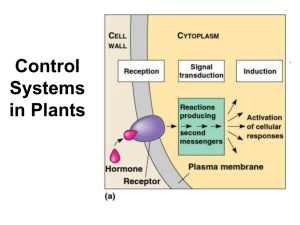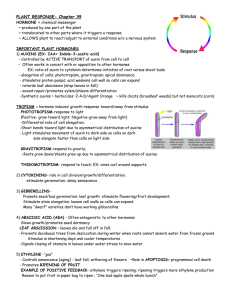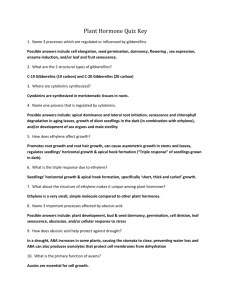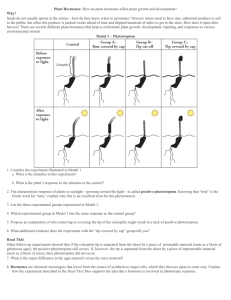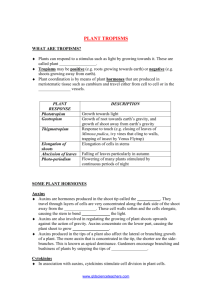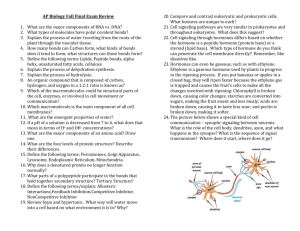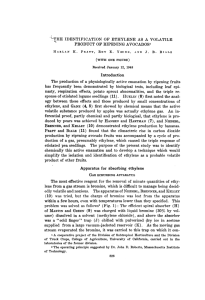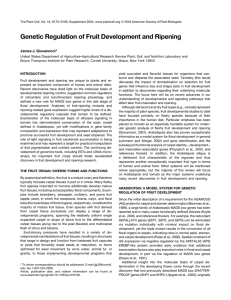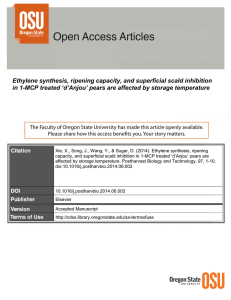Plant Response
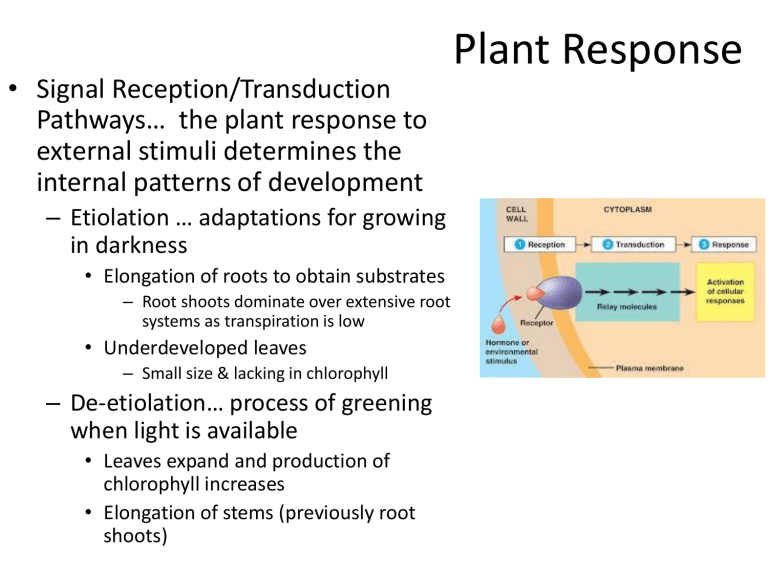
• Signal Reception/Transduction
Pathways… the plant response to external stimuli determines the internal patterns of development
– Etiolation … adaptations for growing in darkness
• Elongation of roots to obtain substrates
– Root shoots dominate over extensive root systems as transpiration is low
• Underdeveloped leaves
– Small size & lacking in chlorophyll
– De-etiolation… process of greening when light is available
• Leaves expand and production of chlorophyll increases
• Elongation of stems (previously root shoots)
Plant Response
Signal Reception-Transduction-
Response
• Studies in de-etiolation demonstrate the model
– Reception… the availability of light activates phytochrome in the cytoplasm of the leaf
– Transduction… even the slightest amount of light causes signal amplification from the phytochrome
• cGMP opens Ca+ channels in the cell membrane
– Activates various kinases that signal production of de-etiolation response proteins
– Response …
• Transcription Regulation
– By activation of specific positive transcription factors by cGMP & Ca+
• Post-translational Modification
– Modification of existing proteins by phosphorylation (kinase activity)
– Protein phosphatases turn off process through dephosphorylating if light is no longer available
Plant Hormones
• Hormones affect plant growth by affecting growth, elongation, and differentiation.
– Due to positive or negative tropism
• Phototropism causes the dark side of the grass to grow faster due to a release in a growth hormone (auxin) resulting in bending toward light
• Each hormone has multiple effects causing a profound effect on plant development
– Most through signal amplification or redirection of metabolism
Hormone types
• Auxins… stimulate elongation (growth)
– Travel from tip to root … polar travel from apical to basal end of the cell
• Used in broadleaf herbicides as they are taken in by leaves causing a hormone overdose
• Cytokinins…activate growth through cell division (cytokinesis)
– Produced in roots (travel up)
– Works in concert with auxins
• The ratio of each determines whether roots or shoots develop
• Apical dominance is exhibited in plants as auxins dominate.
– Apical inhibition is exhibited through decapitation as cytokinins to dominate causing later bud formation
Hormone types
• Gibberellins (GA)… active in growth in leaves and stems, fruit growth, and seed germination
– More than 100 different forms identified
– Facilitates the penetration of expansion proteins through the cell wall
– Work in concert with auxins to promote fruit formation
• Sprayed on fruit to increase size for market
– Activated in the seed after imbibition to signal embryogenisis
Hormone types
• Brassinosteroids… promote cell elongation and differentiation on stems and seedlings.
– Similar to auxins
– Retard abscission (loss of leaves)
• Abscisic Acid (ABA)… antagonizes the other growth hormones to retard growth
– Ratio determines effect
– Present in concentrated amounts in the seed to prevent maturation in the absence of water or light
• “washed out” during imbibition
• The ratio of ABA to GA determines germination
– Helps in drought by causing stomata to stay closed decreasing transpiration
• Ethylene… produced by the plant in times of stress (drought, flooding, mechanical pressure, infection, …) Production causes both cell death and fruit to ripen
– Triple response… produced in high concentrations when a seedling reaches an obstruction causing it to grow sideways
– Apoptosis… a burst of ethylene production is associated with deciduous leave removal in autum and the death of an annual plant
• Process of abscission causing hydrolyzation of polysaccharides holding the leave stem
• Recycling of nutrients and auxins signal new leaves in spring
– Fruit ripening… a burst of production signals ripening by softening the cell walls and sweetening of the fruit through acid and sugar production.
• Storing unripened fruit in a paper bag concentrates ethylene gas to speed ripening
• Commercial fruits are stored in CO2 ventilated containers (retards ethylene production) and exposed to ethylene gas just prior to market
• A rotten apple does spoil the bunch by over production of ethylene causing nearby fruit to spoil

